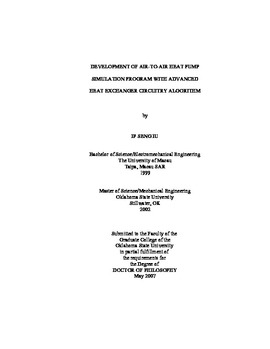| dc.contributor.advisor | Fisher, Daniel E. | |
| dc.contributor.author | Iu, Ip Seng | |
| dc.date.accessioned | 2013-12-10T18:05:17Z | |
| dc.date.available | 2013-12-10T18:05:17Z | |
| dc.date.issued | 2007-05 | |
| dc.identifier.uri | https://hdl.handle.net/11244/7798 | |
| dc.description.abstract | Scope and Method of Study: The purpose of this study was to develop a heat pump simulation program that is capable of simulating complex heat exchanger circuits. A segment-by-segment heat exchanger model has been developed in this research. When modeling the heat exchanger circuitries, local air side and refrigerant side boundary conditions for each heat exchanger segment are necessary information to account for the heat transfer and pressure drop changes. Refrigerant flow distribution in the coil circuits are determined by the flow resistance in each circuit. A novel circuiting algorithm that relaxes the constraints of previous models has been proposed to determine the refrigerant flow distribution. As reported in the literature, air side heat transfer coefficients vary row-by-row in multi-row heat exchangers. An experimental procedure that covers a range of fin densities has been conducted to develop row-by-row heat transfer correlations for louvered fin coils. The heat pump simulation program, with the proposed circuitry algorithm and developed row-by-row correlations integrated, has been validated at both component and system level simulations. The validation is based on a range of experimental data that cover different boundary conditions and system configurations. | |
| dc.description.abstract | Findings and Conclusions: The results of the row-by-row heat transfer experiment showed that there is thermal entrance length effect in the row-by-row heat transfer data. Heat transfer dominates at the front rows because the data are in the developing region. The louvered fin heat transfer data also confirm that there is a transition between "duct flow" and "boundary layer flow". The row effect is particularly significant for duct flow and developing region. However, it is always ignored in overall heat transfer correlations. Simulation results with overall and row-by-row correlations showed that the simulated capacity difference can be as high as 6.5%. The difference can be higher if there is no boundary layer flow in the heat exchangers, such as flat fins. Validation results of the simulation program are satisfactory. A majority of the simulated heat exchanger capacities, sensible heat ratio, compressor power consumptions, and refrigerant mass flow rates are within +-5% difference. Saturation temperatures and coefficient of performance are within +-2K and +-0.5, respectively. | |
| dc.format | application/pdf | |
| dc.language | en_US | |
| dc.rights | Copyright is held by the author who has granted the Oklahoma State University Library the non-exclusive right to share this material in its institutional repository. Contact Digital Library Services at lib-dls@okstate.edu or 405-744-9161 for the permission policy on the use, reproduction or distribution of this material. | |
| dc.title | Development of air-to-air heat pump simulation program with advanced heat exchanger circuitry algorithm | |
| dc.contributor.committeeMember | Spitler, Jeffrey D. | |
| dc.contributor.committeeMember | Ghajar, Afshin J. | |
| dc.contributor.committeeMember | Whiteley, James Robert | |
| osu.filename | Iu_okstate_0664D_2177.pdf | |
| osu.accesstype | Open Access | |
| dc.type.genre | Dissertation | |
| dc.type.material | Text | |
| thesis.degree.discipline | Mechanical Engineering | |
| thesis.degree.grantor | Oklahoma State University | |
